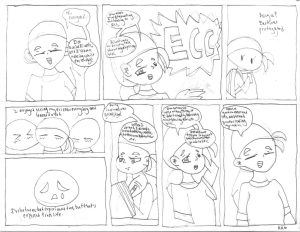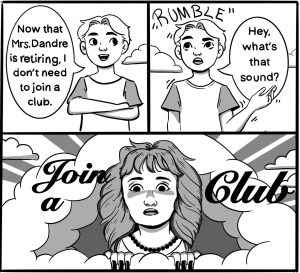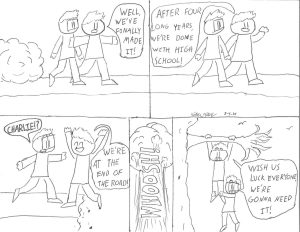In-Depth: Depression in teen girls
A recent CDC report raises concerns about depression rates in teenage girls
The CDC illustrates persistent feelings of sadness or hopelessness in high school students since 2011. Graphic courtesy of the CDC.
March 17, 2023
In the most recent Youth Risk Behavior Survey conducted in 2021, depression rates in teen girls were found to be up by nearly 11 percent from 2019, when the previous report was conducted. According to the Center for Disease Control and Prevention (CDC), The Youth Risk Behavior Survey is a survey given to students through their school and other health organizations every two years, that monitors health-related behaviors that may contribute to the leading causes of death and disability among the nation’s youth. According to the CDC, the number of cases of depression being reported over the course of the last 12 years has proven to be on the rise.
Information from the CDC report and other news outlets relate to a complex issue
Depression is a topic that has become more frequently talked about in recent years, both within the U.S and around the world. Recently, studies have shown that younger females have generally experienced depression and depressive symptoms at higher rates than males of the same age group.
According to the most recent Youth Risk Behavior Survey conducted by the Centers for Disease Control and Prevention, “3 in 5 teen girls felt persistently sad and hopeless, a marker for depressive symptoms, in 2021, up nearly 60% from 2011.” CBS News also reported on the CDC findings, “More than 40% of high school students said that feelings of sadness or hopelessness prevented them from engaging in their regular activities for at least two weeks of the year.”
The CDC reported that “More than 1 in 4 girls reported they seriously considered attempting suicide in 2021, up nearly 60% from 2011…more than 1 in 10 girls reported they attempted suicide in 2021, up 30% from a decade ago.”
According to The Jed Foundation, “…depression is linked to a greater risk of suicide. Researchers estimate that about 60 percent of people who lose their lives to suicide have had a mood disorder such as depression.” In some cases, suicide and depression will connect as mentioned, but, sometimes they may not.
With these increased rates, there is some speculation regarding what may be responsible for the recent increase in depression rates among teen girls. For example, according to the CDC, “Almost 1 in 5 teen girls experienced sexual violence in the past year—a 20% increase since 2017” It is unclear whether this increase in sexual violence towards teen girls may be linked to the recent increase in depression rates. However, as of now, there is no definitive consensus. According to PBS, “Since schools reopened, struggles with female student behavior and mental health have given some schools even more reason to restrict access on cellular devices.”
Some other studies have focused on the impact of cell phones and social media. However, studies have not yet confirmed the specific relationship between these and mental health in teens, male or female.
The Pew Research Center concludes, “Among teen girls who had recent depressive episodes, 45% received treatment for depression over the past year.”
Currently, according to CBS news, “In a recent study of 28,000 children on Medicaid who had visited the emergency room between 2018 and 2019 for depression, anxiety, or self-harm, only about half received outpatient follow-up treatment within a month and about a quarter returned to the hospital within six months.”
According to the CDC, in regards to the future, “With the right programs and services in place, schools have the unique ability to help students thrive.”
Local and national resources
As shown in the CDC study, reported cases of depression among the nation’s youth have been growing for years, but grew by 10% since 2019. It may be hard for some students who may be impacted by depression to seek help, as one of the main symptoms is isolation, but there are local resources available one could consider if they or someone they know is experiencing symptoms of depression.
Tri City Family Services is an organization whose mission is to provide mental health services that are accessible and affordable. According to their website, people facing struggles with their mental health can confide in licensed therapists, social workers, counselors and psychiatrists in order to get the proper help in managing their struggles. Their helpline is available on their website, tricityfamilyservices.org, for anyone to call and set up an appointment for an affordable cost.
NAMI Kane County is another organization offering support to those struggling with depression and other mental health conditions. Their website states “A NAMI Family Support Group is confidential, non-judgmental and facilitated by people who’ve been there and have learned the value of support.” According to NAMI, people will be talking about their feelings with someone that has experienced what they are experiencing. More information is available on their website, namikcn.org.
The St. Charles East website also lists resources for students struggling with their mental health. Under the “students” tab, the student supports website provides a document full of links under different categories such as counseling resources, suicide prevention services, etc.
AP Psychology students share their insights
After the X-ray staff read the recent CDC report on the rates of depression among teen girls, the staff decided to do some more research. Seeing teenage girl depression numbers so high through the CDC on a national level was troubling to read, but to investigate this further, X-ray staff surveyed 64 AP Psychology students who have had at least one semester of experience in a college-level psychology class. Of the 64 students we surveyed, 91% of them said mental health issues are prevalent to some degree at St. Charles East.
While 100% of respondents said that the COVID pandemic played a role in the increased rates of depression in teenage girls, there are other factors to consider, as well.

St. Charles East in their opinion. Graphic by Sophia Smallwood.
When asked what factors besides the pandemic may have affected these increased numbers, one respondent said “Just the fact that everyone is more involved in social media. We are more exposed to certain standards that are
almost impossible to meet, and that just lowers our self-esteem.”
Social media, an ever-evolving device, may prove to be a silent toxin infiltrating our younger generation, and the age in which our youth starts using social media is getting younger by the year.
In a study titled “Middle School Students’ Social Media Use,” conducted by professors at the University of North Carolina Charlotte in 2018, 86.84% of 591 middle school students surveyed said they started using social media at or before age 12. Most social media platforms, including Facebook, Snapchat, Twitter and TikTok, have a 13+ age requirement in order to use their platform.
On top of this, 39.7% of the middle school students surveyed in the study said their parents did not monitor their social media use, and 48.9% of these students were girls. While it is quite possible the standards social media pushes on our youth could be to blame for these inflated depression rates, other AP Psychology students suggest other things could be the culprits.
Things such as stress, athletics, extracurricular activities, gender expectations for women and pressure in multiple areas of life come up in our survey.
43% of AP Psychology students said that there are resources available to support those struggling with their mental health, but that more are needed. 25% said that there are resources available, but they are not easily accessible.
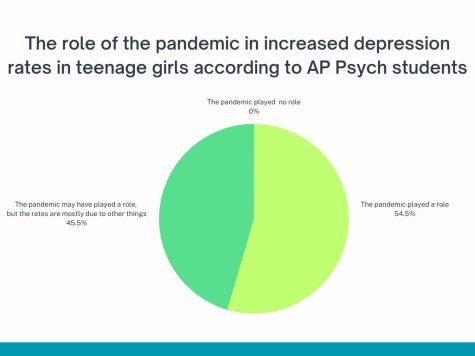
“…more opportunities for support in the community for any reason should be more common. We could always have more support in every aspect,” one respondent said.
Some students also emphasized the importance of breaking the stigma surrounding mental health, and the role it plays in worsening the situation in the first place.
One survey respondent expressed a need to “break the stigma around asking for help as a bad or weak thing.” The solution? Some have a pessimistic approach to this deep-seated, growing problem in America’s teenage girls. When asked what we can do to help those struggling with mental health issues in our own school or community, one survey respondent said “Not much. There is no way to promise to help other than having connections to outside sources who can better help [them].”
Others, though, propose solutions. “There needs to be more personalized plans set in place for people’s specific needs. Often if you are struggling at school and go to the counselors office, no one is any help and they just do the same things for everyone regardless of the situation,” one survey respondent suggests.
Another respondent highlights shortcomings in the way our school deals with mental health issues in students. “It seems as though this school is content with promoting the vague notion that resources for these problems exist, but fail to properly inform students how to access them,” they detailed.
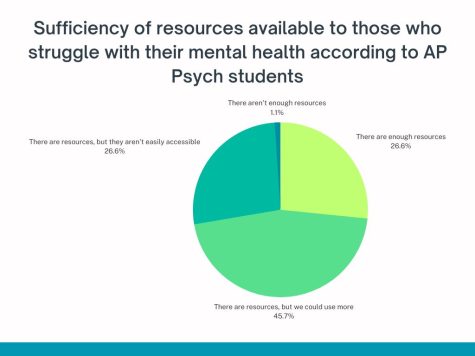
Graphic by Sophia Smallwood.
“Most people will suffer in silence,” another respondent noted. While they are not professionals, AP Psychology students feel that they can provide some insights on how to address many aspects of the problem at hand.







